Today marks the conclusion of the second phase of the Marsa Junction Project, Infrastructure Minister Ian Borg said during an early morning visit to the Marsa project.
He described it as "a project with great importance for our country and a project will which transform the way we look at our country's infrastructure. We are also initiating preparations for the third phase, which will include the building of the flyovers."
"This project, which comes with an investment €70 million will improve essential infrastructure that sees around 8,000 vehicles an hour every day. In total, the second phase of this project included 3 kilometres of new or rebuilt lanes, 6 kilometres of trenches for water, electricity and telecommunication services, 1.2 kilometres of walk-through service culverts for high voltage cables, 1.7 kilometres of rain water catchment system pipes and 400 metres of cycle lanes which will increase during the third phase."
This phase included the rebuilding of Triq il-Gvern Lokali and Triq Ġużé Gatt as well as the widening and rebuilding of Triq Aldo Moro so that it now has ten lanes; a phase which was concluded last night when Infrastructure Malta applied the final layer of asphalt to the northbound Aldo Moro carriageway.
Minister Borg explained how during the work done overnight, around 30 workers used six pavers worked alongside each other to surface the entire carriageway, with around 800 tonnes of asphalt manufactured in three different plants during the same night. Apart from the several layers of hard materials in the foundations beneath the surface, layers of specific material - geotextile and geogrid - were also placed to prolong the lifetime of the road by limiting damages caused by rainwater infiltrating below street level.

Borg said that infrastructural work is no longer limited to the building and surfacing of lanes used by vehicles, and explained how this phase in fact also included the development of pedestrian passages, cycle lanes, safe bus lay-bys and landscaped areas.
"It was a wisely planned phase which led to the saving of time as well as to the limitation of inconveniences, when one considers the great work done where we also had overnight works taking place. I therefore take this opportunity to remind everyone that the roads are empty at night and it is necessary to continue forming a culture where certain works are done at night, even in other sectors," stressed the Minister. He explained how the upcoming days will see the completion of the last few items such as the placing signs and road markings on the new lanes.
Borg looked ahead to the third phase. He explained that Infrastructure Malta has already started infrastructural preparations so that in the coming weeks, work on this phase can begin. It will include the construction of the seven flyover structures instead of the traffic lights junction near the Addolorata Cemetery.
He said that these preparations include a number of temporary lanes in the place of the old factories between Triq Aldo Moro and Triq il-Labour. "Work on these temporary lanes is taking place at a fast pace so that in the coming weeks, these can replace existing lanes in the direction heading towards Paola, where work on the third phase needs to take place. Workers will begin constructing the foundations of the first flyover, which will go from Triq Aldo Moro to Triq Garibaldi."

He also welcomed the contractor who came from Turkey to work on this important phase, as well as his employees, and looked ahead to collaboration towards another productive and efficient phase.
Infrastructure Malta CEO Fredrick Azzopardi gave a technical explanation on the building of the flyovers and the other aspects of the third phase, while he said that the Agency will continue planning and working hard so that this project can continue being implemented in the best way possible.
"The Marsa Junction Projects includes the building of new roads, a system of seven flyovers on different levels, passageways and lanes for walking and cycling, park and ride facilities, landscaped areas and other infrastructure to improve the quality, safety and efficiency of the busiest junction in Malta's road system. The project will drastically reduce travelling times and air pollution caused by traffic congestion by removing the present traffic light system near the Addolorata Cemetery, to be replaced by 12 kilometres of new lanes that lead directly to each of the different directions that connect to one another in this area," a statement read
The Marsa Junction Project is co-financed by the Connecting Europe Facility of the European Union.